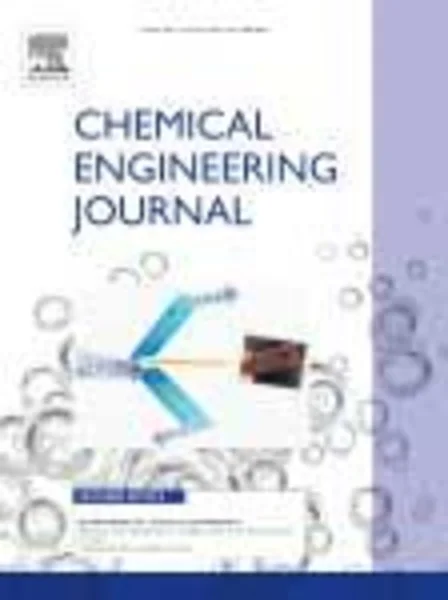-
photochemical degradation of vinyl chloride with an advanced reduction process (arp) – effects of reagents and ph
جزئیات بیشتر مقاله- تاریخ ارائه: 1392/01/01
- تاریخ انتشار در تی پی بین: 1392/01/01
- تعداد بازدید: 599
- تعداد پرسش و پاسخ ها: 0
- شماره تماس دبیرخانه رویداد: -
a new treatment technology, called an advanced reduction process (arp), was developed by combining uv irradiation with reducing reagents to produce highly reactive reducing free radicals that degrade contaminants. batch experiments were performed under anaerobic conditions to investigate the degradation of vinyl chloride (vc) by this arp. all degradation reactions were found to follow a pseudo-first-order decay model and the rate constants (kobs) were characterized for all experimental conditions. the influence of ph on kobs was studied in experiments with direct photolysis as well as experiments with arps using reagents activated by ultraviolet (uv) light. values for kobsin direct photolysis were found to be 0.012, 0.011, and 0.018 min−1 at ph 3, 7 and 10, respectively. values of most of the kobs in experiments with arp increased at all ph values compared with corresponding values obtained for direct photolysis. the increase in kobs was due to the production of reactive species produced by photochemical reaction of the reducing reagents with uv light. the ph effect on kobs observed with the arp can be explained in terms of changes in the absorption spectra of the reagents at various ph. the rate of light absorption determines the rate of formation of the reactive species which determines the rate of contaminant degradation. chloride ion and chloroethane were detected as the products of vc degradation. the increase in ph value was shown to promote the transformation of vc to chloride.
مقالات جدیدترین رویدادها
-
استفاده از تحلیل اهمیت-عملکرد در ارائه الگوی مدیریت خلاقیت سازمانی و ارائه راهکار جهت بهبود
-
بررسی تاثیر ارزش وجوه نقد مازاد بر ساختار سرمایه شرکت های پذیرفته شده در بورس اوراق بهادار تهران
-
بررسی تأثیر سطح افشای ریسک بر قرارداد بدهی شرکت های پذیرفته شده در بورس اوراق بهادار تهران
-
بررسی تأثیر رتبه بندی اعتباری مبتنی بر مدل امتیاز بازار نوظهور بر نقد شوندگی سهام با تأکید بر خصوصی سازی شرکت ها
-
تأثیر آمیخته بازاریابی پوشاک ایرانی بر تصویر ذهنی مشتری پوشاک ایرانی (هاکوپیان)
-
رویکردی نوین جهت افزایش آستانه تحمل پذیری خطا در نرم افزار
-
توسعه پایدار روستائی با رویکرد برنامه ریزی در جهت کارآفرینی در گردشگری و صنایع دستی روستائی
-
تعیین شاخص های کمی مکان یابی جهت احداث سد زیرزمینی (مطالعه موردی دشت رامهرمز)
-
بررسی گونه های مخمر در تولید اتانول از آب پنیر در فرآیند ناپیوسته در فرمانتور میکس و بیوراکتور ایرلیفت
-
reduction of nox in fe-edta and fe-nta solutions by an enriched bacterial population
مقالات جدیدترین ژورنال ها
-
مدیریت و بررسی افسردگی دانش آموزان دختر مقطع متوسطه دوم در دروان کرونا در شهرستان دزفول
-
مدیریت و بررسی خرد سیاسی در اندیشه ی فردوسی در ادب ایران
-
واکاوی و مدیریت توصیفی قلمدان(جاکلیدی)ضریح در موزه آستان قدس رضوی
-
بررسی تاثیر خلاقیت، دانش و انگیزه کارکنان بر پیشنهادات نوآورانه کارکنان ( مورد مطالعه: هتل های 3 و 4 ستاره استان کرمان)
-
بررسی تاثیر کیفیت سیستم های اطلاعاتی بر تصمیم گیری موفق در شرکتهای تولیدی استان اصفهان (مورد مطالعه: مدیران شرکتهای تولیدی استان اصفهان)
-
بررسی بازاریابی دیجیتال و استراتژی های بازاریابی دیجیتال در ایران
-
اصول و شاخصه های سبک زندگی قرآنی (مطالعه موردی هر یک از اعضاء خانواده)
-
سوء استفاده از کودکان در جرائم از دیدگاه داخلی و بین المللی
-
بررسی ارتباط بین شاخص نفوذپذیری ثانویه (spi) با خورند دوغاب در توده سنگ ساختگاه سد سیمره
-
ارائه یک رویکرد ترکیبی پویا جهت تخصیص منابع در محیط ابری موبایل مبتنی بر الگوریتم های fcm و ژنتیک باینری




سوال خود را در مورد این مقاله مطرح نمایید :